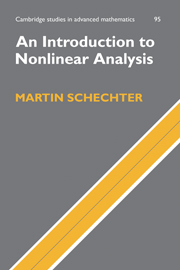
-
Select format
-
- Publisher:
- Cambridge University Press
- Publication date:
- August 2010
- January 2005
- ISBN:
- 9780511608742
- 9780521843973
- 9780521605137
- Dimensions:
- (228 x 152 mm)
- Weight & Pages:
- 0.737kg, 384 Pages
- Dimensions:
- (229 x 152 mm)
- Weight & Pages:
- 0.56kg, 382 Pages
You may already have access via personal or institutional login
Book description
The techniques that can be used to solve non-linear problems are far different than those that are used to solve linear problems. Many courses in analysis and applied mathematics attack linear cases simply because they are easier to solve and do not require a large theoretical background in order to approach them. Professor Schechter's 2005 book is devoted to non-linear methods using the least background material possible and the simplest linear techniques. An understanding of the tools for solving non-linear problems is developed whilst demonstrating their application to problems in one dimension and then leading to higher dimensions. The reader is guided using simple exposition and proof, assuming a minimal set of pre-requisites. For completion, a set of appendices covering essential basics in functional analysis and metric spaces is included, making this ideal as an accompanying text on an upper-undergraduate or graduate course, or even for self-study.
Reviews
Review of the hardback:'… presents an introduction to critical point theory addressed to students with a modest background in Lebesgue integration and linear functional analysis. Many important methods from nonlinear analysis are introduced in a problem oriented way … well written … should be present in the library of any researcher interested in Lévy processes and Lie groups.'
Source: Zentralblatt MATH
Contents
Metrics
Full text views
Full text views help Loading metrics...
Loading metrics...
* Views captured on Cambridge Core between #date#. This data will be updated every 24 hours.
Usage data cannot currently be displayed.
Accessibility standard: Unknown
Why this information is here
This section outlines the accessibility features of this content - including support for screen readers, full keyboard navigation and high-contrast display options. This may not be relevant for you.
Accessibility Information
Accessibility compliance for the PDF of this book is currently unknown and may be updated in the future.


